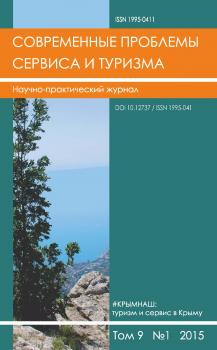The article is devoted to studying the possibilities of the revival of Russian small historical cities through the tourism development. Preservation of Russian identity and patriotism cannot be without an appeal to ancestral roots and the past of a small homeland. Today in Russia there are 800 small towns, where 20 million people live, or 15% of the population of our country. The crisis of the 1990s was especially damaging to small Russian cities, according to official statistics, almost a third of total low-income people in country live here. Unemployment, low incomes, outflow of economically active population, social diseases, poverty, lack of social and cultural infrastructure are the most pressing problems of small Russian towns. At the same time, in the world practice for a long time there has been a tendency to transform small towns with a rich history into tourism centers, which have a special appeal in comparison with the well-known giants. The article explores the potential of the small Russian city of Urzhum in Kirov region – a model of the nineteenth-century Russian merchant city. The authors reveal the originality of its history and architecture, the role of Old Believer merchants in its development, and picturesque neighborhoods untouched by civilization. Urzhum is associated with the names of prominent figures of culture, art and politics: V.M. Vasnetsova, N.V. Zabolotsky, N.T. Tvardovsky, S.M. Kirov. All of the above offers great opportunities for the development of cognitive, eventual, ecological, rural, as well as various types of active tourism on Urzhum land.
small historical towns, merchant cities, timber merchants, мerchants – Old Believers, Urzhum, Vyatka, Russian Turek, Vasnetsovsky round dances
1. Ablova N.O. Ocenka ekonomicheskogo potenciala malyh i srednih gorodov kak instrument upravleniya organami regional'noy i mestnoy vlasti // Ezhemesyachnyy nauchnyy zhurnal. 2015. № 2 (7).
2. Burov A.N. Malye goroda: istoricheskie sud'by i vozmozhnye puti razvitiya // Sociologiya goroda. 2012. № 4. C. 17-28.
3. Varyzgina A., Key R. Vospriyatie bednosti v malom gorode Rossii // Zhurnal issledovaniy social'noy politiki. 2014. T.12. № 4. C. 555-568.
4. Kadyshev G.I. Rol' malyh gorodov v istorii Rossii // Vestnik VolgGASU. Ser.: Stroitel'stvo i arhitektura. 2013. Vyp. 31-1(50). C. 84-86.
5. Laamarti Yu.A., Kofanov A.V. Malye goroda v sovremennoy Rossii // Sociologiya goroda. 2012. № 4. C. 3-16.
6. Perov G.O., Kuz'menko N.F., Kudryavcev D.I. Problemy molodezhnoy bezraboticy v srednem rossiyskom gorode: monografiya. M.: RUSAYNS, 2017. 116 s.
7. Afanas'ev O.E. Tipologiya turistskih klasterov, vklyuchennyh v FCP «Razvitie v'ezdnogo i vnu- trennego turizma v Rossiyskoy Federacii» // Sovremennye problemy servisa i turizma. 2016. T.10. № 1. S. 37-46. DOI:https://doi.org/10.12737/17782.
8. Rasseko Yu.Yu. Zarubezhnyy opyt razvitiya malyh gorodov // Belarus' i mirovye ekonomicheskie processy: Sb. nauch. st. Minsk: BGU, 2015. C. 192-200.
9. Skalon A.V. Malyy gorod: SWOT-analiz problemnogo polya // Regional'nye issledovaniya. 2009. № 6(29). S. 9-18.
10. Held D., Gol'dblatt D., Makgryu E., Perraton Dzh. Global'nye transformacii: Politika, ekonomika, kul'tura. M.: Praksis, 2004. 576 s.
11. Ninemeier J.D., Perdue J. Discovering Hospitality and Tourism: The World’s Greatest Industry. Upper Saddle River, NJ: Pearson Prentice Hall, 2008. 680 p.
12. Wood R.S. The Dynamics of Incrementalism: Subsystems, Politics, and Publik Lands // Policy Studies Journal. 2006. Vol.34. No.1. Pp. 1-16. DOI:https://doi.org/10.1111/j.1541-0072.2006.00153.x.
13. Wallerstain I. Geopolitics and Geoculture. Cambridge: Cambridge Univ. Press, 2001.





